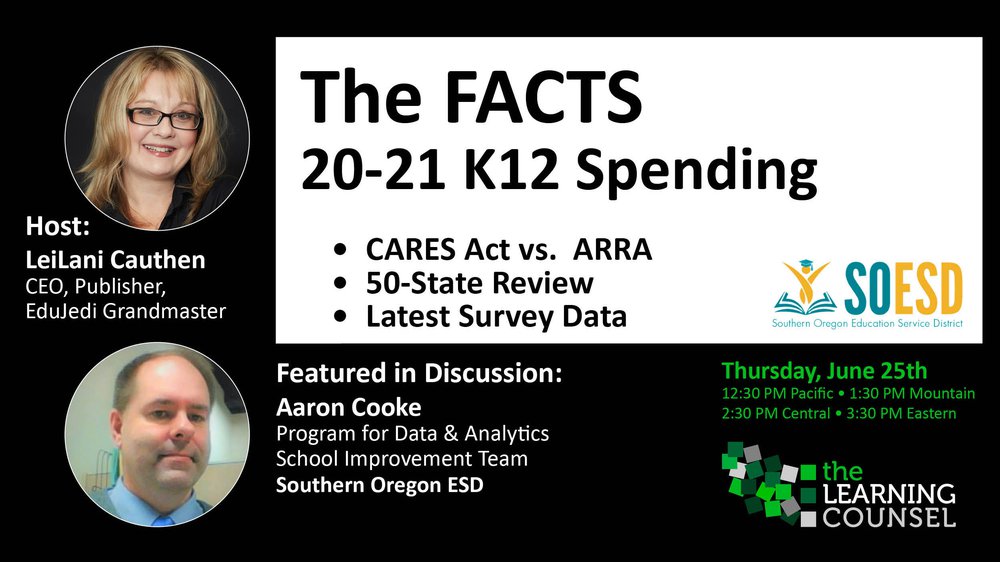Knowledge is a powerful thing for EdTech companies. Understanding the way money is really distributed during this unusual time of COVID-19 and the CARES Act can be the difference between failure and success on a magnitude never before seen in the EdTech industry. These are confusing times, and media reports of money shortages in education abound. However, having the right inside information can unwrap a bounty of available funding that others miss, and now is no time to sit on the sidelines and watch other companies add market share and enjoy unprecedented success.
According to LeiLani Cauthen, CEO and Publisher at the Learning Counsel, “We just concluded a well-attended webinar that was education-facing. And we asked our panelists, what are they doing with their CARES Act money? Many of them are beginning to spend or making their preparations. And it's a wide variety of spend that they're already doing. We've been doing a series of national surveys to accompany our series of webinars, to find out what people were saying. The last one we did had 18,631 responses. We are hearing from a lot of different districts right now, and the interesting thing is, the spend is off the charts!
“My uncle was a Senator in California. I used to sit in the offices of several senators and one assemblyman. Quite a bit of my family worked in the legislature and listened to what was called a squawk box for the arguments down on the voting floor for both houses in California. What always interested me is the cycle of how things get done. So, I'm going to walk you through this.
“This is the cycle we see when we're looking at this from the EdTech side, what you see publicly is a lot of bad news. You see public political announcements and the deficits and the cut numbers, and they all sound huge. Meanwhile, leadership in the districts and all the way up to the state agencies are submitting their likely cuts. They'd been told, you're going to take a 10 percent hit or a 12 percent hit while they're continuing to lobby for return of their budget. That never stops. They're always lobbying for more money and then downstream into the district and school level. Those operational cuts are implemented, but we're going to be giving you a caveat on that. So, everyone believes and communicates that legitimate cuts have been made. That's what everyone believes. They've always believed that the stories bubble out to the media about areas that are hardest hit, to demonstrate real suffering is commensurate out to the public so that the public doesn't feel like they should pick up a Pitchfork and go raid the state because they're out of a job.
“And meanwhile, everybody's still getting paid in government. So later when the revenue’s increased, you never hear about that. You haven't been hearing about that for the seven years that it's been up. So, no teacher ever believed there was plenty of money in education. So, in the meantime behind the scenes, there are political announcements are being made, but they're always missing several elements, like what is the exact definition on amount of reserves? A lot of States have that huge billions in reserves that will be used to cover the hole temporarily. They don't actually speak to all facets of the stimulus impact, including what happened when everybody in America got a $1,200 stimulus check, what that did to their tax revenue and other facets of bailouts.
“Those are figured in, and then the previous year's revenue from an up-fiscal was still in play. As we closed out this last school year, they don't talk about the normal rate of retirement impact for jobs savings and sort of other unknowns, including arcane things related to their legal liabilities and disbursement timetables. So, the leadership then reports up, of course, what cuts could be made, but they operate in those percentages. But remember they're nonprofit, downstream must spend all their allocations from last year, which was an up year. So, we saw, and we'll be seeing through the end of June last year's up spending, having to be spent because it was already allocated the impact of the other elements in number one, then show up later. And there's a gradual and sudden behind the scenes budget that downstream leaders rarely ever hear about because it might go to some other department.
“So, the critical priorities are chosen by any level of regulators, state level, district level, as to what districts, what schools, what departments and projects receive this back channel ad hoc funding, which must be spent in a rushed manner. So, a lot of spending starts to fly under the radar of public view to be used up prior to the deadlines that can be seen in final reporting much later. So, the reason we're bringing this up, if you are not making yourself known, they're not going to reach out to you. There's a huge tendency right now for schools and districts to go under the formal RFP RFI access for information bidding because that's all publicly viewable, which means if you're on their prior list, they're asking you, what's it going to cost? That's not duplicitous, It's just the way things work. We've seen state budgets increase every year for the last seven years, California, for example, is a huge boom town of increased revenue. You have to look under the hood to see where the money really is and where they put it.”
According to Aaron Cooke, Coordinator on the Southern Oregon ESD School Improvement Team, “Oregon operates very differently than some other States. So, Oregon is very much a locally controlled educational system. And while some of those locally controlled systems are very top down, tech directors make decisions and pieces like that, actually very few of them operate that way. And I would say less of them operate that way now than they did six months ago. And the reason for that is that people are trying to find things that can work in an environment that they're not used to. And they're very open to actually looking at new things and the people that are listening to, the people actually do have the time to either take your calls or to look at those things.”
The real fun begins when you add in the $13.2 Billion in the K-12 CARES ACT funding, as well as the $3 Billion that is going directly to governors and another $300 Million in competitive grants. To the well-informed, the second half of 2020 will be a spending free-for-all, with Learning Counsel predictions placing the overall education technology spend up as high as 40 percent. But the truth is, this is insider-baseball. To get to the real money, you need to know the way things work. In this special Learning Counsel virtual discussion, you’ll hear a state-by-state analysis and you will be a true insider, ready to increase your sales and gain significant market share. And best of all, you’ll be helping America’s learners prosper in this uncertain time.
Watch the video
You’ll want to see this powerful presentation, explaining the true pathways for school and district spending in the wake of the pandemic, and unlocking the mysteries of what promises to be the richest pool of available EdTech funding ever seen.











